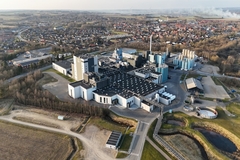
- Industry news
Industry news
- Category news
Category news
- Reports
- Key trends
- Multimedia
- Journal
- Events
- Suppliers
- Home
- Industry news
Industry news
- Category news
Category news
- Reports
- Key trends
- Multimedia
- Events
- Suppliers
Seafibrex: UK researchers scale natural seaweed ingredient for functional food reformulation
Through a series of application trials, Seafibrex, a seaweed-derived functional fiber ingredient, has demonstrated its applicability in three popular food formats: pork sausages, vegan burgers, and gluten-free bread.
The patent-pending ingredient is extracted from sustainably cultivated brown seaweed (Alaria esculenta) using BioMara’s proprietary process.
Food technologists at the UK’s University of Nottingham’s Food Innovation Centre (FIC), in collaboration with BioMara, completed the application trials.
BioMara provided the ingredient and technical background, while the FIC at the University of Nottingham designed and ran the formulation and analysis trials across meat, plant-based, and bakery formats.
“The primary focus of this work was to assess the functional properties of Seafibrex when incorporated into common food matrices and evaluate the impact it had on the moisture and oil retention, structure, texture, and flavor of the products,” says Jessica Gray, food technologist at the University of Nottingham.

“In many cases, Seafibrex delivered comparable or improved results versus traditional ingredients. It was particularly effective at delivering mouthfeel and flavor in reduced-fat and reduced-salt applications, meaning Seafibrex shows real potential for reformulation projects involving salt and fat reduction.”
The research was supported under Innovate UK’s “Better Food for All” initiative, which is scaling healthier food reformulations, “without requiring changes in consumer behavior.”
The findings reveal that Seafibrex can increase fiber across all three product categories, without sacrificing texture or flavor. It helps reduce fat and common binders like methylcellulose in plant-based formats and may also improve the structure creation and texture in gluten-free recipes.
 Seafibrex is rich in dietary fiber and bioactive marine polysaccharides and applicable across diverse food formats.Rich in fiber and polysaccharides
Seafibrex is rich in dietary fiber and bioactive marine polysaccharides and applicable across diverse food formats.Rich in fiber and polysaccharides
Rich in dietary fiber and bioactive marine polysaccharides, the ingredient was evaluated for its impact on texture, water retention, cook performance, and sensory acceptability across several food systems.
The researchers tested Seafibrex at different levels in pork sausages (2.5%, 5%, and 10%), including reduced-fat and reduced-salt versions.
They highlight the 2.5% addition level was the most viable from a sensory and processing perspective, offering improved moisture retention without negatively affecting flavor or texture.
Moisture content and oil loss in cooking were positively impacted by Seafibrex, particularly at 5% inclusion.
The reduced-fat formulation (50% less pork belly, 5% Seafibrex) demonstrated greater moisture retention and high acceptability in sensory tests, offering a potential route for healthier sausage formulations.
“Seafibrex enabled greater water holding in reduced-fat formulations, which is critical for maintaining juiciness and delivering flavor in reduced-fat sausages,” adds Gray.
Seaweed burgers
The vegan burger trials investigated Seafibrex as a replacement for methylcellulose and pea fiber, across standard and reformulated (reduced-fat/salt) recipes.
At 2.5% inclusion, Seafibrex retained the optimal texture and moisture while avoiding “fishy” flavor notes often associated with marine ingredients. Meanwhile, a 5% addition supported fat reduction by enhancing water binding, allowing for a 50% reduction in oil with “good structure maintenance.”
The trials identified texture and water-holding advantages, suggesting Seafibrex could support clean-label reformulation by reducing the need for synthetic binders.
Hydrocolloid alternative for gluten-free bread
The FIC also assessed Seafibrex in gluten-free bread, comparing its performance with commonly used hydrocolloids (psyllium husk and carboxymethylcellulose) and assessing optimal water addition methods.
Loaves with 2% Seafibrex (added directly to the dry ingredients) delivered comparable structure, volume, and texture to psyllium husk without perceptible marine flavors.
Notably, pre-hydration of Seafibrex was unnecessary as it did not positively impact the final loaf, which helps to simplify processing.
At 2% direct addition, Seafibrex created a more open, sourdough-style crumb, which may be advantageous for certain gluten-free formulations.
“Seafibrex’s ability to create and maintain structure in gluten-free systems is particularly valuable given the challenges associated with clean-label gluten-free bakery reformulation,” notes Gray.
These results complement earlier work conducted in collaboration with Abertay University, UK, and bakery ingredient supplier Macphie that demonstrated the successful application of Seafibrex in muffins and breads.










